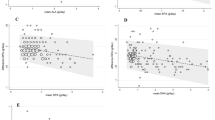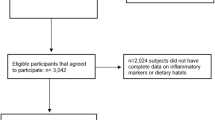Abstract
Objective:
To validate selected nutrients assessed by the food frequency questionnaire (FFQ) used in the Harvard cohort studies in an African-American group.
Design:
Blood aliquots were pooled for each decile of intake of two carotenoids and alpha tocopherol as measured by FFQ. These pooled samples were analyzed for nutrient content, and the resultant blood levels were plotted against the median for each decile of intake. In addition, adipose tissue samples taken from each man were analyzed for content of specific fatty acids. We calculated the Spearman correlations comparing intakes of specific fatty acids as percent of total fat intake, adjusted for energy intake, as measured by FFQ, with the percentage of the corresponding fatty acid in adipose tissue.
Subjects and settings:
African-American men (N=104) with prostate cancer were recruited from a Detroit physician's practice and completed a detailed FFQ.
Results:
Comparing decile 10 with decile 1 intake of nutrients as measured by FFQ, there was a 32% higher blood level of lycopene, a 288% higher blood level of beta carotene and a 100% higher blood level of alpha tocopherol. The Spearman correlation coefficients between intakes of linoleic acid, alpha linolenic acid, long-chain n-3 fatty acids and trans fatty acid measured by FFQ and the corresponding adipose tissue levels were between 0.10 and 0.47.
Conclusion:
The FFQ was able to distinguish meaningful differences in biochemical measurements of selected nutrients and presumably corresponding differences in the extremes of intake in African-American men with prostate cancer who were likely to be motivated to report accurately. However, the results found are similar to those found in other populations.
Sponsorship:
This work was supported by United States National Institutes of Health Grants CA42182 and CA72036.
This is a preview of subscription content, access via your institution
Access options
Subscribe to this journal
Receive 12 print issues and online access
$259.00 per year
only $21.58 per issue
Buy this article
- Purchase on Springer Link
- Instant access to full article PDF
Prices may be subject to local taxes which are calculated during checkout

Similar content being viewed by others
References
The Alpha tocopherol, Beta carotene Cancer Prevention Study Group (1994). The effect of vitamin E and beta carotene on the incidence of lung cancer and other cancers in male smokers 330, 1029–1035.
Ascherio A, Hennekens CH, Buring JE, Master C, Stampfer MJ, Willett WC (1994). Trans fatty acids intake and risk of myocardial infarction. Circulation 89, 94–101.
Ascherio A, Rimm EB, Giovannucci EL, Spiegelman D, Stampfer MJ, Willett WC (1996). Dietary fat and risk of coronary heart disease in men: cohort follow up study in the United States. Br Med J 313, 84–90.
Ascherio A, Rimm EB, Stampfer MJ, Giovannucci E, Willett WC (1995). Dietary intake of marine n-3 fatty acids, fish intake and the risk of coronary disease among men. N Engl J Med 332, 977–982.
Ascherio A, Stampfer MJ, Colditz GA, Rimm EB, Litin L, Willett WC (1992). Correlations of vitamin A and E intakes with the plasma concentrations of carotenoids and tocopherols among American men and women. J Nutr 122, 1792–1801.
Baylin A, Kabagambe EK, Siles X, Campos H (2002). Adipose tissue biomarkers of fatty acid intake. Am J Clin Nutr 76, 750–757.
Beynen AC, Katan MB (1985). Rapid sampling and long-term storage of subcutaneous adipose-tissue biopsies for determination of fatty acid composition. Am J Clin Nutr 42, 317–322.
Campbell DR, Gross MD, Martini MC, Grandits GA, Slavin JL, Potter JD (1994). Plasma carotenoids as biomarkers of vegetable and fruit intake. Cancer Epidemiol Biomarkers Prev 3, 493–500.
Coates RJ, Eley JW, Block G, Gunter EW, Sowell AL, Grossman C et al. (1991). An evaluation of a food frequency questionnaire for assessing dietary intake of specific carotenoids and vitamin E among low-income black women. Am J Epidemiol 134, 658–671.
Djuric Z, Uhley VE, Depper JB, Brooks KM, Lababidi S, Heilbrun LK (1999). A clinical trial to selectively change dietary fat and/or energy intake in women: the women's diet study. Nutr Cancer 34, 27–35.
El-Sohemy A, Baylin A, Kabagambe E, Ascherio A, Spiegelman D, Campos (2002). Individual carotenoid concentrations in adipose tissue and plasma as biomarkers of dietary intake. Am J Clin Nutr 76, 172–179.
Fawzi WW, Rifas-Shiman SL, Rich-Edwards JW, Willett WC, Gillman MW (2004). Calibration of a semi-quantitative food frequency questionnaire in early pregnancy. Ann Epidemiol 14, 754–762.
Forman D, Sitas F, Newell DG, Stacey AR, Boreham J, Peto R et al. (1990). Geographic association of helicobacter pylori antibody prevalence and gastric cancer mortality in rural China. Int J Cancer 46, 608–611.
Garland M, Sacks FM, Colditz GA, Rimm EB, Sampson LA, Willett WC et al. (1998). The relation between dietary intake and adipose tissue composition of selected fatty acids in US women. Am J Clin Nutr 67, 25–30.
Giovannucci E, Ascherio A, Rimm EB, Stampfer MJ, Colditz GA, Willett WC (1995). Intake of carotenoids and retinol in relation to risk of prostate cancer. J Natl Cancer Inst 87, 1767–1776.
Giovannucci E, Rimm EB, Colditz GA, Stampfer MJ, Ascherio A, Chute CC et al. (1993a). A prospective study of dietary fat and risk of prostate cancer. J Natl Cancer Inst 85, 1571–1579.
Giovannucci E, Rimm EB, Stampfer MJ, Colditz GA, Ascherio A, Willett WC (1994). Intake of fat, meat, and fiber in relation to risk of colon cancer in men. Cancer Res 54, 2390–2397.
Giovannucci E, Rimm EB, Wolk A, Ascherio A, Stampfer MJ, Colditz GA et al. (1998). Calcium and fructose intake in relation to risk of prostate cancer. Cancer Res 58, 442–447.
Giovannucci E, Rimm EB, Liu Y, Stampfer MJ, Willett WC (2002). A prospective study of tomato products, lycopene, and prostate cancer risk. J Natl Cancer Inst 94, 391–398.
Giovannucci E, Stampfer MJ, Colditz GA, Rimm EB, Trichopolous D, Rosner BA et al. (1993b). Folate, methionine, and alcohol intake and risk of colorectal adenoma. J Natl Cancer Inst 85, 875–884.
Godley PA, Campbell MK, Miller C, Gallagher P, Martinson FE, Mohler JL et al. (1996). Correlation between biomarkers of omega-3 fatty acid consumption and questionnaire data in African American and Caucasian United States males with and without prostatic carcinoma. Cancer Epidemiol Biomarkers Prev 5, 115–119.
Goodman EG, Thornquist M, Kestin M, Metch B, Anderson G, Omenn GS (1996). The association between participant characteristics and serum concentrations of b-carotene, retinol, retinyl palmitate, and α-tocopherol among participants in the Carotene and Retinol Efficacy Trial (CARET) for prevention of lung cancer. Cancer Epidemiol Biomarkers Prev 5, 815–821.
Holland G, Welch AA, Unwin ID, Buss DH, Paul AA, Southgate DAT (1991). McCance and Widdowson's the composition of foods, 5th edn. The Royal Society of Chemists: UK.
Hunter DJ, Rimm EB, Sacks FM, Stampfer MJ, Colditz GA, Litin LB et al. (1992). Comparison of measures of fatty acid intake by subcutaneous fat aspirate, food frequency questionnaire, and diet records in a free-living population of US men. Am J Epidemiol 135, 418–427.
Jacques PF, Sulsky SI, Sadowski JA, Phillips JC, Rush D, Willett WC (1993). Comparison of micronutrient intake measured by a dietary questionnaire and biochemical indicators of micronutrient status. Am J Clin Nutr 57, 182–189.
Liang KY, Zeger SL (1993). Regression analysis for correlated data. Ann Rev Publ Health 14, 43–68.
London SJ, Sacks FM, Caesar J, Stampfer MJ, Siguel E, Willett WC (1991). Fatty acid composition of subcutaneous adipose tissue and diet in post-menopausal US women. Am J Clin Nutr 54, 340–345.
Longnecker MP, Lissner L, Holden JM, Flack VF, Taylor PR, Stampfer MJ et al. (1993). The reproduciblity and validity of a self-administered semi-quantitative food frequency questionnaire in subjects from South Dakota and Wyoming. Epidemiology 4, 356–365.
Michaud DS, Giovannucci EL, Ascherio A, Rimm EB, Forman MR, Sampson L et al. (1998). Associations of plasma carotenoid concentrations and dietary intake of specific carotenoids in samples of two prospective cohort studies using a new carotenoid database. Cancer Epidem Biomar Prevent 7, 283–290.
Paul AA, Southgate DA (1978). McCance and Widdowson's the composition of foods. Her Majesty's Stationery Office: London, England.
Pennington JAT, Bowes AD, Church HN (1998). Bowes and Church's food values of portions commonly used. Lippincott-Raven: Philadelphia.
Powell I (1997). Prostate cancer and African American men. Oncology 11, 599–605.
Resnicow K, Odom E, Wang T, Dudley WN, Mitchell D, Vaughan R et al. (2000). Validation of three food frequency questionnaires and 24-hour recalls with serum carotenoid levels in a sample of African-American adults. Am J Epidemiol 152, 1072–1080.
SAS Institute Inc. (1996). Version 6.12, SAS Institute, Inc.: Cary, NC.
SEER and NCHS Mortality by race and age 1973–1995.
Stryker WS, Kaplan LA, Stein EA, Stampfer MJ, Sober A, Willett WC (1988). The relation of diet, cigarette smoking, and alcohol consumption to plasma beta-carotene and alpha-tocopherol levels. Am J Epidemiol 127, 283–296.
USDA (1996). U.S. Department of Agriculture Nutrient Database for Standard Reference, Release 11. Nutrient Data Laboratory Home Page: http://www.nal.usda.gov/fnic/foodcomp.
USDA (1998). U.S. Department of Agriculture Nutrient Database for Standard Reference, Release 12. Nutrient Data Laboratory Home Page: http://www.nal.usda.gov/fnic/foodcomp.
Vogt TM, Mayne ST, Graubard BI, Swanson CA, Sowell AL, Schoenberg JB et al. (2002). Serum lycopene, other serum carotenoids, and risk of prostate cancer in US Blacks and Whites. Am J Epidemiol 155, 1023–1032.
Wahrendorf J, Hanck AB, Munoz N, Vuilleumier JP, Walker AM (1986). Vitamin measurements in pooled blood samples. Am J Epidemiol 123, 544–550.
Weinberg CR, Umbach DM (1999). Using pooled exposure assessment to improve efficiency in case–control studies. Biometrics 55, 718–726.
Willett W (1998). Nutritional epidemiology. Oxford University Press: New York.
Willett WC, Sampson L, Stampfer MJ, Rosner B, Bain C, Witschi J et al. (1985). Reproducibility and validity of a semiquantitative food frequency questionnaire. Am J Epidemiol 122, 51–65.
Willett WC, Stampfer MJ, Underwood BA, Speizer FE, Rosner B, Hennekens CH (1983a). Validation of a dietary questionnaire with plasma carotenoid and alpha-tocopherol levels. Am J Clin Nutr 38, 631–639.
Willett WC, Stampfer MJ, Underwood BA, Taylor JO, Hennekens CH (1983b). Vitamins A, E, and carotene: effects of supplementation on their plasma levels. Am J Clin Nutr 38, 559–566.
Yong L-C, Forman MR, Beecher GR, Graubard BI, Campbell WS, Reichman ME et al. (1994). Relationship between dietary intake and plasma concentrations of carotenoids in premenopausal women: application of the USDA–NCI carotenoid food-composition database. Am J Clin Nutr 60, 223–230.
Author information
Authors and Affiliations
Corresponding author
Additional information
Contributors: MH planned the study, supervised data collection, performed statistical analyses and contributed to writing of the paper. IP planned the study, supervised data collection, contributed to writing of the paper. HC advised on the methods of handling, transport and analysis of specimens, supervised the analysis of specimens, contributed to writing of the paper. MS sought funding and contributed to the writing of the paper. EG sought funding and contributed to the writing of the paper. WW planned the study and contributed to the writing of the paper.
Rights and permissions
About this article
Cite this article
Holmes, M., Powell, I., Campos, H. et al. Validation of a food frequency questionnaire measurement of selected nutrients using biological markers in African-American men. Eur J Clin Nutr 61, 1328–1336 (2007). https://doi.org/10.1038/sj.ejcn.1602641
Received:
Revised:
Accepted:
Published:
Issue Date:
DOI: https://doi.org/10.1038/sj.ejcn.1602641
Keywords
This article is cited by
-
Reproducibility and validity of the Toronto-modified Harvard food frequency questionnaire in a multi-ethnic sample of young adults
European Journal of Clinical Nutrition (2023)
-
Just you wait… and fill out this survey. Discussion of the methodological aspects of waiting room surveys
Health Services and Outcomes Research Methodology (2022)
-
Validity of food frequency questionnaire-based estimates of long-term long-chain n-3 polyunsaturated fatty acid intake
European Journal of Nutrition (2014)
-
A Taiwanese food frequency questionnaire correlates with plasma docosahexaenoic acid but not with plasma eicosapentaenoic acid levels: questionnaires and plasma biomarkers
BMC Medical Research Methodology (2013)
-
Omega-3 fatty acids status in human subjects estimated using a food frequency questionnaire and plasma phospholipids levels
Nutrition Journal (2012)



